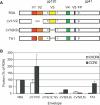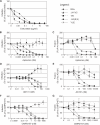V3 loop truncations in HIV-1 envelope impart resistance to coreceptor inhibitors and enhanced sensitivity to neutralizing antibodies
- PMID: 17722977
- PMCID: PMC1950945
- DOI: 10.1371/journal.ppat.0030117
V3 loop truncations in HIV-1 envelope impart resistance to coreceptor inhibitors and enhanced sensitivity to neutralizing antibodies
Abstract
The V1/V2 region and the V3 loop of the human immunodeficiency virus type I (HIV-1) envelope (Env) protein are targets for neutralizing antibodies and also play an important functional role, with the V3 loop largely determining whether a virus uses CCR5 (R5), CXCR4 (X4), or either coreceptor (R5X4) to infect cells. While the sequence of V3 is variable, its length is highly conserved. Structural studies indicate that V3 length may be important for interactions with the extracellular loops of the coreceptor. Consistent with this view, genetic truncation of the V3 loop is typically associated with loss of Env function. We removed approximately one-half of the V3 loop from three different HIV-1 strains, and found that only the Env protein from the R5X4 strain R3A retained some fusion activity. Loss of V1/V2 (DeltaV1/V2) was well tolerated by this virus. Passaging of virus with the truncated V3 loop resulted in the derivation of a virus strain that replicated with wild-type kinetics. This virus, termed TA1, retained the V3 loop truncation and acquired several adaptive changes in gp120 and gp41. TA1 could use CCR5 but not CXCR4 to infect cells, and was extremely sensitive to neutralization by HIV-1 positive human sera, and by antibodies to the CD4 binding site and to CD4-induced epitopes in the bridging sheet region of gp120. In addition, TA1 was completely resistant to CCR5 inhibitors, and was more dependent upon the N-terminal domain of CCR5, a region of the receptor that is thought to contact the bridging sheet of gp120 and the base of the V3 loop, and whose conformation may not be greatly affected by CCR5 inhibitors. These studies suggest that the V3 loop protects HIV from neutralization by antibodies prevalent in infected humans, that CCR5 inhibitors likely act by disrupting interactions between the V3 loop and the coreceptor, and that altered use of CCR5 by HIV-1 associated with increased sensitivity to changes in the N-terminal domain can be linked to high levels of resistance to these antiviral compounds.
Conflict of interest statement
Figures






References
-
- Burton DR, Desrosiers RC, Doms RW, Koff WC, Kwong PD, et al. HIV vaccine design and the neutralizing antibody problem. Nat Immunol. 2004;5:233–236. - PubMed
-
- Wei X, Decker JM, Wang S, Hui H, Kappes JC, et al. Antibody neutralization and escape by HIV-1. Nature. 2003;422:307–312. - PubMed
-
- Hughes ES, Bell JE, Simmonds P. Investigation of population diversity of human immunodeficiency virus type 1 in vivo by nucleotide sequencing and length polymorphism analysis of the V1/V2 hypervariable region of env. J Gen Virol. 1997;78:2871–2882. - PubMed
Publication types
MeSH terms
Substances
Associated data
- Actions
- Actions
- Actions
Grants and funding
LinkOut - more resources
Full Text Sources
Molecular Biology Databases
Research Materials

